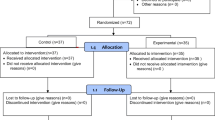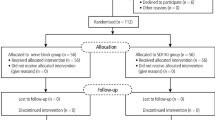Abstract
Objectives
The study aimed to compare the two local anesthetic techniques: inferior alveolar nerve block (IANB) and intraligamentary anesthesia (ILA) during the restorative treatment of mandibular first permanent molars in pediatric patients.
Materials and methods
In this randomized, controlled, cross-over, single-blind, split-mouth study, participants were divided into two groups: group 1, ILA in the first session and IANB in the second session, and group 2, IANB in the first session and ILA in the second session. The pain perception was analyzed using the visual analog scale (VAS) and Wong-Baker FACES pain rating scale (WBFPRS). Heart rate, arterial oxygen saturation (SpO2), and postoperative complications were recorded. The data were analyzed with the Brunner-Langer model, Spearman correlation analysis, Fisher’s exact t-test, chi-square, and McNemar tests.
Results
Seventy-eight patients aged between 6 and 12 years were included. The session effect was not statistically significant in ILA (p = 0.762 and p = 0.411) for pain scores while it was significant in IANB (p < 0.001 for each score). There was no significant difference in the VAS, WBFPRS, heart rate, and SpO2 between the anesthesia techniques (p = 0.454, p = 0.436, p = 0.406, p = 0.285, respectively). Postoperative complications increased in the IANB technique in the first session.
Conclusions
Intraligamentary anesthesia may be an alternative technique to IANB for the restorative treatment of mandibular first permanent molars in pediatric patients. In the first session, clinicians may choose the ILA instead of IANB.
Clinical relevance
In clinical procedures, administering anesthesia, which is effective, is less painful, and poses relatively low complication risk, has significant importance in sustaining children’s cooperation with dental treatment.

Similar content being viewed by others
Data availability
Not applicable.
References
Koch G, Poulsen S (2013) Pediatric dentistry: a clinical approach, 2nd edn. Blackwell Publishing Ltd., UK, pp 17–60
Palm AM, Kirkegaard U, Poulsen S (2004) The wand versus traditional injection for mandibular nerve block in children and adolescents: perceived pain and time of onset. Pediatr Dent 26:481–484
San Martin-Lopez AL, Garrigos-Esparza LD, Torre-Delgadillo G, Gordillo-Moscoso A, Hernandez-Sierra JF, de Pozos-Guillen AJ (2005) Clinical comparison of pain perception rates between computerized local anesthesia and conventional syringe in pediatric patients. J Clin Pediatr Dent 29:239–243. https://doi.org/10.17796/jcpd.29.3.jgh607l870051882
Malamed SF (2020) Handbook of local anesthesia e-book. Techniques of mandibular anesthesia, 7th edn. Elsevier, St. Louis, p 257–285
Chi D, Kanellis M, Himadi E, Asselin ME (2008) Lip biting in a pediatric dental patient after dental local anesthesia: a case report. J Pediatr Nurs 23:490–493. https://doi.org/10.1016/j.pedn.2008.02.035
Meechan JG (2002) Supplementary routes to local anesthesia. Int Endod J 35:885–896. https://doi.org/10.1046/j.1365-2591.2002.00592.x
Malamed SF (2020) Handbook of local anesthesia e-book. Supplemental injection technique, 7th edn. Elsevier, St. Louis, p 286–306.
von Baeyer CL (2006) Children’s self-reports of pain intensity: scale selection, limitations and interpretation. Pain Res Manag 11:157–162. https://doi.org/10.1155/2006/197616
Witt N, Coynor S, Edwards C, Bradshaw H (2016) A guide to pain assessment and management in the neonate. Curr Emerg Hosp Med Rep 4:1–10. https://doi.org/10.1007/s40138-016-0089-y
Allen KD, Kotil D, Larzelere RE, Hutfless S, Beiraghi S (2002) Comparison of a computerized anesthesia device with a traditional syringe in preschool children. Pediatr Dent 24:315–320
Tekin U, Ersin N, Oncag O, Bent B, Menderes M, Kocanali B (2012) Comparison of inferior alveolar nerve block and intraligamentary anesthesia on the discomfort of children. J Int Dent Med Res 5:143–148
Bataineh AB, Alwarafi MA (2016) Patient’s pain perception during mandibular molar extraction with articaine: a comparison study between infiltration and inferior alveolar nerve block. Clin Oral Investig 20:2241–2250. https://doi.org/10.1007/s00784-016-1712-8
Sixou JL, Marie-Cousin A, Huet A, Hingant B, Robert JC (2009) Pain assessment by children and adolescents during intraosseous anesthesia using a computerized system (QuickSleeper). Int J Paediatr Dent 19:360–366. https://doi.org/10.1111/j.1365-263X.2009.00983.x
Kühnisch J, Daubländer M, Klingberg G et al (2017) Best clinical practice guidance for local analgesia in paediatric dentistry: an EAPD policy document. Eur Arch Paediatr Dent 18:313–321. https://doi.org/10.1007/s40368-017-0311-y
American Academy of Pediatric Dentistry (2022) Behavior guidance for the pediatric dental patient. The Reference Manual of Pediatric Dentistry. American Academy of Pediatric Dentistry, Chicago, pp 321–393
Gupta A, Wadhwa J, Aggarwal V, Mehta N, Abraham D, Aneja K, Singh A (2022) Anesthetic efficacy of supplemental intraligamentary injection in human mandibular teeth with irreversible pulpitis: a systematic review and meta-analysis. J Dent Anesth Pain Med 22:1–10. https://doi.org/10.17245/jdapm.2022.22.1.1
Kämmerer PW, Schiegnitz E, von Haussen T et al (2015) Clinical efficacy of a computerised device (STA™) and a pressure syringe (VarioJect INTRA™) for intraligamentary anesthesia. Eur J Dent Educ 19:16–22. https://doi.org/10.1111/eje.12096
Versloot J, Veerkamp JS, Hoogstraten J (2008) Pain behaviour and distress in children during two sequential dental visits: comparing a computerised anesthesia delivery system and a traditional syringe. Br Dent J 205:E2-31. https://doi.org/10.1038/sj.bdj.2008.414
Youssef BR, Söhnel A, Welk A et al (2021) RCT on the effectiveness of the intraligamentary anesthesia and inferior alveolar nerve block on pain during dental treatment. Clin Oral Investig 25:4825–4832. https://doi.org/10.1007/s00784-021-03787-x
Kämmerer PW, Adubae A, Buttchereit I, Thiem DGE, Daubländer M, Frerich B (2018) Prospective clinical study comparing intraligamentary anesthesia and inferior alveolar nerve block for extraction of posterior mandibular teeth. Clin Oral Investig 22:1469–1475. https://doi.org/10.1007/s00784-017-2248-2
Alamoudi NM, Baghlaf KK, Elashiry EA, Farsi NM, El Derwi DA, Bayoumi AM (2016) The effectiveness of computerized anesthesia in primary mandibular molar pulpotomy: a randomized controlled trial. Quintessence Int 47:217–224. https://doi.org/10.3290/j.qi.a34977
Baghlaf K, Alamoudi N, Elashiry E, Farsi N, El Derwi DA, Abdullah AM (2015) The pain-related behavior and pain perception associated with computerized anesthesia in pulpotomies of mandibular primary molars: a randomized controlled trial. Quintessence Int 46:799–806. https://doi.org/10.3290/j.qi.a34553
Haghgoo R, Taleghani F (2015) Comparison of periodontal ligament injection and inferior alveolar nerve block in mandibular primary molars pulpotomy: a randomized control trial. J Int Oral Health 7:11–14
Lin S, Wigler R, Huber R, Kaufman AY (2017) Anaesthetic efficacy of intraligamentary injection techniques on mandibular molars diagnosed with asymptomatic irreversible pulpitis: a retrospective study. Aust Endod J 43:34–37. https://doi.org/10.1111/aej.12169
Aggarwal V, Singla M, Miglani S, Kohli S, Sharma V, Bhasin SS (2018) Does the volume of supplemental intraligamentary injections affect the anaesthetic success rate after a failed primary inferior alveolar nerve block? A randomized-double blind clinical trial. Int Endod J 51(1):5–11. https://doi.org/10.1111/iej.12773
Thoppe-Dhamodhara YK, Asokan S, John BJ, Pollachi-Ramakrishnan G, Ramachandran P, Vilvanathan P (2015) Cartridge syringe vs computer controlled local anesthetic delivery system: pain related behaviour over two sequential visits - a randomized controlled trial. J Clin Exp Dent 7:e513-518. https://doi.org/10.4317/jced.52542
Hembrecht EJ, Nieuwenhuizen J, Aartman IH, Krikken J, Veerkamp JS (2013) Pain-related behaviour in children: a randomised study during two sequential dental visits. Eur Arch Paediatr Dent 14:3–8. https://doi.org/10.1007/s40368-012-0003-6
Ram D, Peretz B (2001) Reactions of children to maxillary infiltration and mandibular block injections. Pediatr Dent 23:343–346
Cianetti S, Lombardo G, Lupatelli E et al (2017) Dental fear/anxiety among children and adolescents A systematic review. Eur Arch Paediatr Dent 18:121–130. https://doi.org/10.23804/ejpd.2017
Alsadat FA, El-Housseiny AA, Alamoudi NM, Elderwi DA, Ainosa AM, Dardeer FM (2018) Dental fear in primary school children and its relation to dental caries. Niger J Clin Pract 21:1454–1460. https://doi.org/10.4103/njcp.njcp_160_18
Sirintawat N, Sawang K, Chaiyasamut T, Wongsirichat N (2017) Pain measurement in oral and maxillofacial surgery. J Dent Anesth Pain Med 17:253–263. https://doi.org/10.17245/jdapm.2017.17.4.253
Campanella V, Libonati A, Nardi R et al (2018) Single tooth anesthesia versus conventional anesthesia: a cross-over study. Clin Oral Investig 22:3205–3213. https://doi.org/10.1007/s00784-018-2413-2
Dumbrigue HB, Lim MV, Rudman RA, Serraon A (1997) A comparative study of anesthetic techniques for mandibular dental extraction. Am J Dent 10:275–278
Acknowledgements
The authors would like to thank Assoc. Prof. Dr. Timur Köse and Research Assistant Semiha Özgül for the statistical analysis.
Funding
This study was supported by İzmir Katip Çelebi University Scientific Research Projects Coordination (Grant number: 2019-TDU-DİŞF-0013).
Not applicable.
Author information
Authors and Affiliations
Contributions
EY and FCD designed the study. EY performed clinical procedures. FCD and EY collected and analyzed the data. EY and FCD wrote the main manuscript. All authors critically reviewed the final draft of the manuscript.
Corresponding author
Ethics declarations
Ethics approval
This study was approved by the Ethics Committee at İzmir Katip Celebi University (#15/2020) and was conducted in accordance with the Declaration of Helsinki. The study was published on ClinicalTrials.gov (NCT05115773). All participants and their legal guardians were informed about the study and signed informed consent forms.
Competing interests
The authors declare no competing interests.
Additional information
Publisher's note
Springer Nature remains neutral with regard to jurisdictional claims in published maps and institutional affiliations.
Supplementary Information
Below is the link to the electronic supplementary material.
Rights and permissions
Springer Nature or its licensor (e.g. a society or other partner) holds exclusive rights to this article under a publishing agreement with the author(s) or other rightsholder(s); author self-archiving of the accepted manuscript version of this article is solely governed by the terms of such publishing agreement and applicable law.
About this article
Cite this article
Yılmaz, E., Çağırır Dindaroğlu, F. Comparison of the effectiveness of intraligamentary anesthesia and inferior alveolar nerve block on mandibular molar teeth in pediatric patients: a randomized controlled clinical study. Clin Oral Invest 27, 3071–3082 (2023). https://doi.org/10.1007/s00784-023-04911-9
Received:
Accepted:
Published:
Issue Date:
DOI: https://doi.org/10.1007/s00784-023-04911-9




